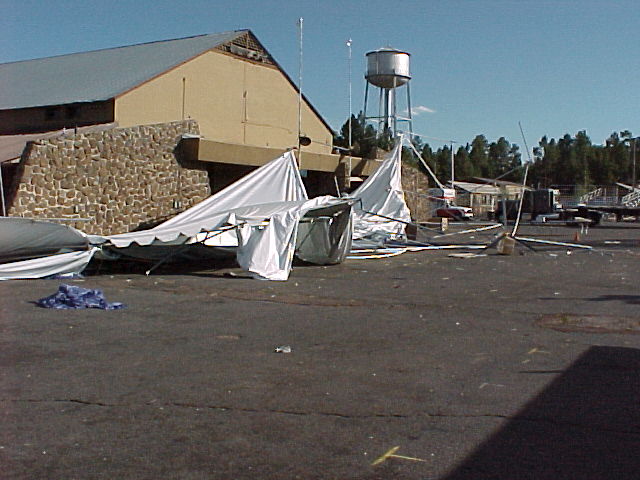
A strong atmospheric river will continue heavy rain over southern California through Friday. The heaviest rainfall is ongoing today in the Los Angeles Basin. Flash and urban flooding is possible. A prolonged heavy snowfall has begun over the Sierra Nevada Mountains and will continue through Friday. Travel will become increasingly difficult over the passes due to snow and strong winds. Read More >
Dust Devils in Northern Arizona
![]()
 |
| An example of a dust devil (Copyright: John Roenfeldt-Inflow Images) |
A common wind phenomenon that occurs throughout much of the world, including Arizona, are dust devils. An example of a dust devil can be seen to the left. These dust-filled vortices, created by strong surface heating, are generally smaller and less intense than a tornado. Typical diameters of dust devils range from 10 to 300 feet, with an average height of approximately 500 to 1000 feet. In most locations, dust devils typically last only a few minutes before dissipating. Although, in deserts typical of northern Arizona, dust devils can reach heights of several thousand feet and last on the order of an hour or more. Wind speeds in larger dust devils can reach 60 mph or greater. Even though they are generally smaller than tornadoes, dust devils can still be destructive as they lift dust and other debris into the air. Small structures can be damaged, and even destroyed, if in the path of a strong dust devil.
Dust devils form in areas of strong surface heating, usually at the interface between different surface types, such as asphalt and dirt, or even irrigated fields and dirt roads. Typically, they occur under clear skies and light winds, when the ground can warm the air to temperatures well above the temperatures just above the ground. This is a very unstable condition, since the heated air is less dense and lighter than the cooler air above it. If the temperature of the ground becomes much warmer than the air above it, vertical mixing will take place to release this unstable configuration. Once the ground heats up enough, a localized pocket of air will quickly rise through the cooler air above it. The sudden uprush of hot air causes air to speed horizontally inward to the bottom of the newly-forming vortex. This rapidly rising pocket of air may begin to rotate, and if it continues to be stretched in the vertical direction, will increase in rotation speed. This increase in rotation speed from vertical stretching is similar to the increased spinning of an ice skater as they bring their arms in toward their bodies. As more hot air rushes in toward the developing vortex to replace the air that is rising, this spinning effect is intensified. A s the air rises, it cools and eventually will descend back through the center of the vortex. Under optimal conditions, a balance between the hot air rising along the outer wall of the vortex and the cooler air sinking in the vortex occurs. The dust devil then begins to move across the ground, picking up more and more dust, which highlights the vortex making it visible to the eye. The dust devil, once formed, is a funnel-like chimney through which hot air moves both upward and circularly. If a steady supply of warm unstable air is available for the dust devil, it will continue to move across the ground. However, once the warm unstable air is depleted or the balance is broken in some other way, the dust devil will break down and dissipate.
s the air rises, it cools and eventually will descend back through the center of the vortex. Under optimal conditions, a balance between the hot air rising along the outer wall of the vortex and the cooler air sinking in the vortex occurs. The dust devil then begins to move across the ground, picking up more and more dust, which highlights the vortex making it visible to the eye. The dust devil, once formed, is a funnel-like chimney through which hot air moves both upward and circularly. If a steady supply of warm unstable air is available for the dust devil, it will continue to move across the ground. However, once the warm unstable air is depleted or the balance is broken in some other way, the dust devil will break down and dissipate.
Dust devils can form anywhere in Arizona, due to a combination of our southern latitude and increased solar heating, our dry sandy soil types, and large areas of lightly vegetated terrain. Because of the necessity of warm clear days and light winds, dust devils occur most frequently over northern Arizona in the months of May and June, but can occur at anytime during the year under the right conditions. Dust devils are most prevalent in the desert regions, but can occur even in the forests of the Mogollon Rim. A good place to look for dust devils is along the boundary between irrigated fields or forest meadows and dry, sunbaked ground or dirt roadways, usually between 11 a.m. and 2 p.m. when the sun is most intense.
On September 14, 2000, a large well-defined dust devil hit the Coconino County Fairgrounds causing property damage and personal injuries. Tents were blown down and a ticket booth was knocked over. A large wooden beam in one of the pavilions was split due to the strong winds. Due to this amount of damage, it is estimated that wind speeds may have reached up to 75 mph. Dust devils are not only common to our planet, but have also been found on Mars as well.